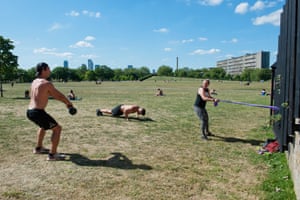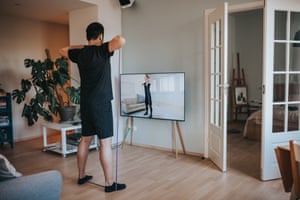Will you go to the gym when it reopens?
In a corner of Kennington Park in south London, Joe, 51, and Gary, 46, are doing a workout they have clearly done before. They have long resistance bands, tied to a fence, and are executing a routine of gym classics: squats, lunges and pushups.
Before lockdown, Gary and Joe were your classic gymgoers: they went for the weights, not the classes, four times a week for at least an hour each time, Gary before work, Joe after. They are both very aware of the possibilities for viral transmission in a room full of people whose raison d’être is to breathe heavily and cover everything in sweat.
Will they go back, I ask, when the gyms reopen? Joe says he might put more of the outdoors into his workouts. Gary thinks their gym, which is fairly upmarket, will cope better than others, since the owners have the money to deep clean it and separate the equipment.
The more they talk, though, the more the caution evaporates. “I’m pretty committed to training,” Joe concludes. “I’ll probably risk anything.” Gary says: “Missing the ritual of going to the gym is the thing that’s affected me most over this whole crisis.” I am a bit surprised. What about work? “I’m fine working from home; I didn’t particularly like talking to people at work.” He prefers not to reveal his job.

I speak to nearly 20 exercisers in all, some in the park, others online. They often start off trenchant, particularly if they are a little older. “Nothing until there’s a vaccine,” says Jerome, 57, from Inverness. “Too much heavy breathing and sweat.” But then they start to list what they miss: the community (this is young-person-speak for “other people”); the pump classes; the reformer pilates; the motivation; the feeling alive.
From March 23, exercise became a bigger part of the lives of many people in Britain, as we struggled to find a routine – or, more importantly, a legitimate reason to go outside. Across the UK, the initial guidance allowed one form of exercise once a day (Michael Gove even suggested a time limit – one hour for a walk and 30 minutes for a run). But for many people, keeping fit was huge already: nearly 10 million Britons were members of a gym or fitness club, generating £1.9bn a year and keeping almost 7,000 establishments afloat. If we don’t go back to our old ways, the effect will be seismic.
There is a basic wariness of being around others if it is not essential, which is intensified in the gym environment. It is not just the panting, but also the changing rooms, the potential for sudden, accidental proximity – think Zumba next to an uncoordinated person – and the multiple everyday intimacies that we never used to think about.
This will definitely be a bigger feature for some people than others. James Stark runs two gyms in Bristol, one of which is exclusively for personal training sessions, while the other operates small group sessions as well. “It’s pretty easy to adapt those to new restrictions, because we ran a controlled model anyway, in terms of the personnel and the gym space. We always knew who was going to be in when.”
Only outdoor gyms in England are allowed to reopen from 4 July, but the culture secretary, Oliver Dowden, has suggested that indoor spaces in England will be given the all-clear in the middle of July, with people required to book slots. It will be much more difficult for budget gyms, Stark explains, because “their model ran on 70% of their members never showing up”. If you had to spell out who would be allowed in, at what time, a lot of people would realise that they were rationed to almost nothing – and it is hard to see anyone paying for that.
Risk aversion will affect some chains more than others. Stark refers to big health clubs, “where the audience was more families and the older members who were going to the cafe. Those outfits will struggle. Members are going to be very reluctant to use that kind of facility if they’re high risk. Families are going to wonder whether it’s worth the anxiety.”
There is consensus among people who used gyms for weights, though: calisthenics is not the same; a Hiit workout online is not the same; nothing else is the same. Stark, who runs upmarket gyms for focused young people with goals and spreadsheets, is confident that his clientele will come roaring back.

The yoga and pilates crowd have similar traits, in so far as they get a lot from it and it takes a lot to dissuade them from going to classes. Michele Pernetta, who founded the hot yoga franchise Fierce Grace, says simply: “Once you do yoga, once you really do it, you’re never going to give it up.” She has four studios in London, others in Italy and New York, and speaks regularly to 40 or 50 other studio owners, so she has a bird’s-eye view of what lifting lockdown will look like and what this kind of exerciser wants.
Pernetta says all studios have made the Zoom adaptation pretty well and the classes are fuller online than they were before. People prefer live exercise classes to recorded ones, because it gives them a sense of sharing the experience with others. But from her observations, and surveys done in London and New York: “People are desperate to get back to the studio. You can’t beat getting corrected [by a teacher], you can’t beat the group energy. People are social, aren’t they? When you see other people working hard, it makes you work harder.”
Most successful yoga classes packed people in like theatres, an inch between mats; throw in 40C heat (Fierce Grace is cooler than that, in the mid-20s, but it feels like a furnace) and this is expensive to run even at capacity, never mind with two metres between each person. “Right now, the landlords are basically in charge of the fitness industry,” Pernetta says. “If you’ve got one that isn’t willing to play ball, you just can’t survive.”
Underneath all the sweet talk early in the pandemic, when there was a lot of solidarity from the ground up in the fitness industry – many independent gyms reported that people were paying their membership fees even while they were closed to help keep them afloat, while governments made soothing noises about no one getting evicted – the reality is brutal. Studios will be liable for arrears, during exactly the period when they are trying to adapt their businesses to a new model of many fewer clients.
Plus, in the first flush of lockdown, a lot of people spent a lot of money adapting to it. That is fine if it went on sportswear; if anything, it will motivate people to get back to the gym, since what is the point if you can’t show off your new gear? The brands Pour Moi and My Gym Wardrobe say their sales have risen by nearly 500%, while trainers have seen a similar boost: Saucony says its sales went up 300%.
But what if you bought a bike? Dominic Langan, the CEO of freewheel.co.uk, says: “Bike sales to trade have doubled; clothing and helmet sales are up 708%.” Sure, some of this will be commuters cycling in order to avoid public transport and may not count as a workout at all. But if I were trying to making a living from running a spin class, I would be worried.
And that is before you even get on to the turbo trainer, a machine you fix to the back of your bike that turns it into an exercise bike. If you then get on to a platform such as Zwift, you can race other people from your living room. It is peculiarly addictive and extremely physically taxing. Chris Snook, a spokesman for Zwift, said they had 16,000 concurrent users in December 2019. By April, that had more than doubled, to 35,000.

More importantly, the profile of the users has changed. “Historically, we’ve really targeted enthusiasts and used professional cyclists in our marketing, and that might have been a bit daunting for the newer cyclists,” says Snook.
It seems that, in the grip of lockdown, beginners just got over it and joined anyway. So, there is this new self-sufficiency, born of necessity, which cannot bode well for an industry that partly builds its customer loyalty by getting hold of people when they are out of shape and don’t know what they are doing and holding their hands until they do. Plus, turbo trainers are expensive: the cheapest are about £200; I borrowed one that cost £1,200. It would be psychologically painful to stash that in a cupboard while you go back to the gym.
One more nail in the coffin – anecdotally, at least, based on my sample of interviewees: most people chose their gym because it was near their office, rather than near their house. So, if we don’t go back to work, we don’t go back to play squash. However, it is possible that we will, at some point, go back to work.
So why, with all these swirling augurs, do most people in the industry sound quite upbeat? Partly, I am sure, it is all the endorphins; people who do a lot of exercise are well adjusted and optimistic, it is just a fact. But they do anticipate a bounceback for a reason. Working out from home is, like having a Zoom meeting, fun while it is a novelty and bearable when there is no alternative. Once there is another option, though, the downsides become insistent: your whole house shakes, the other people in it get in the way and laugh at you.
Kate Smurthwaite, 44, a comedian and activist, embarked on a popular online fitness programme that comprised an almost daily workout for nine weeks. “I’m definitely fitter than I was before lockdown; I’m quarantoned,” Smurthwaite says. “But I really miss the trainers at the gym. I knew them, they knew me. I’m quite chatty. I miss doing a class and seeing someone I always used to compete with, or checking out the room and seeing a new person and trying to encourage them.”
People have been publishing workouts that don’t require equipment for decades; often only the aesthetic changes, so the Canadian air force recruits whom people were copying in the 50s become the Elle Macphersons of the 80s, but they were all doing essentially the same thing – and none of them with any bar bells. “I’m not about to install one of those,” Smurthwaite says.
But the thing that is missing from the home workout is not any piece of kit; it is the other people (unless you work out with your flatmates). Lou Taylor, 42, a textile designer, says: “I can’t wait for work-gym-home to be separate things again.” This was the theme of a recent New Yorker cartoon, which was captioned: “I can’t figure out if I’m working from home or living at work”.
When asked why they go to the gym, people talk about the burn, the sense of achievement, seeing results and sometimes – although I have never heard it said unironically – living their best lives. But when you have tried and succeeded in getting all those things in your bedroom, you realise what was really going on: you went to see other people – and nothing is the same without them. That is why, with so much to worry about, the fitness industry does not seem especially worried.



